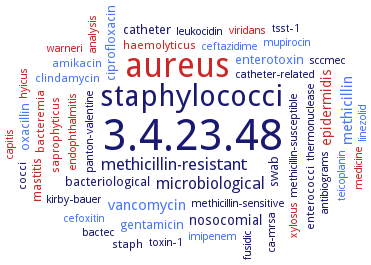3.4.23.48: plasminogen activator Pla
This is an abbreviated version!
For detailed information about plasminogen activator Pla, go to the full flat file.

Word Map on EC 3.4.23.48 
-
3.4.23.48
-
aureus
-
staphylococci
-
methicillin-resistant
-
microbiological
-
methicillin
-
vancomycin
-
nosocomial
-
epidermidis
-
gentamicin
-
mastitis
-
catheter
-
enterotoxin
-
oxacillin
-
swab
-
ciprofloxacin
-
bacteriological
-
cocci
-
amikacin
-
clindamycin
-
enterococci
-
saprophyticus
-
haemolyticus
-
staph
-
bacteremia
-
methicillin-susceptible
-
catheter-related
-
viridans
-
mupirocin
-
tsst-1
-
antibiograms
-
linezolid
-
xylosus
-
kirby-bauer
-
panton-valentine
-
hyicus
-
ceftazidime
-
thermonuclease
-
cefoxitin
-
analysis
-
medicine
-
leukocidin
-
teicoplanin
-
methicillin-sensitive
-
endophthalmitis
-
warneri
-
fusidic
-
sccmec
-
toxin-1
-
imipenem
-
ca-mrsa
-
bactec
-
capitis
- 3.4.23.48
- aureus
-
staphylococci
-
methicillin-resistant
-
microbiological
- methicillin
- vancomycin
-
nosocomial
- epidermidis
- gentamicin
- mastitis
-
catheter
- enterotoxin
- oxacillin
-
swab
- ciprofloxacin
-
bacteriological
-
cocci
- amikacin
- clindamycin
-
enterococci
- saprophyticus
- haemolyticus
-
staph
- bacteremia
-
methicillin-susceptible
-
catheter-related
- viridans
- mupirocin
-
tsst-1
-
antibiograms
- linezolid
- xylosus
-
kirby-bauer
-
panton-valentine
- hyicus
- ceftazidime
- thermonuclease
- cefoxitin
- analysis
- medicine
-
leukocidin
- teicoplanin
-
methicillin-sensitive
- endophthalmitis
- warneri
-
fusidic
-
sccmec
-
toxin-1
- imipenem
-
ca-mrsa
-
bactec
- capitis
Reaction
Converts human Glu-plasminogen to plasmin by cleaving the Arg560-/-Val peptide bond that is also hydrolysed by the mammalian u-plasminogen activator and t-plasminogen activator. Also cleaves arginyl bonds in other proteins =
Synonyms
beta-Pla, coagulase, fibrinolysin, outer membrane protease, Pla, Pla protease, plasminogen activator, plasminogen activator Pla, plasminogen activator protease Pla, YapE
ECTree
Advanced search results
Cloned
Cloned on EC 3.4.23.48 - plasminogen activator Pla
Please wait a moment until all data is loaded. This message will disappear when all data is loaded.
BL21-DE3 used as a host to express recombinant protein, cloning into pBluescript SK+ to produce plasmid pBLA4L
expressed in Escherichia coli TG1, strains BL21 and BL21(DE3)pLys used for expression of recombinant proteins
-
expression in Escherichia coli
gene pla, recombinant expression in a DELTAcroP mutant strain of Citrobacter rodentium and in Escherichia coli strain BL21
Pla is encoded by the 9.5 kb Yersinia pestis plasmid pPCP, sequence comparisons
Pla is encoded by the 9.5 kb Yersinia pestis plasmid pPCP, sequencing of pla genes from 118 Yersinia pestis subsp. microtus isolates, sequence comparisons
tetracycline-responsive promoter system in Yersinia pestis applied to control primary pneumonic plague progression after activation/inhibition of plasminogen activator Pla expression
the mutant enzyme T259I is expressed in Escherichia coli XL1 Blue cells and in Yersinia pestis strain KIM D34
-


 results (
results ( results (
results ( top
top





